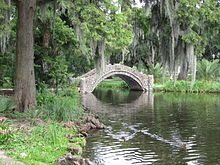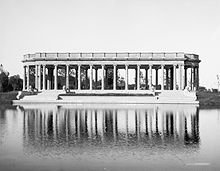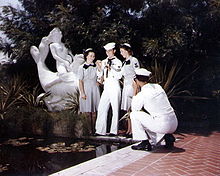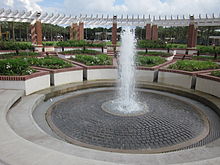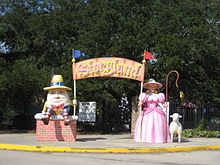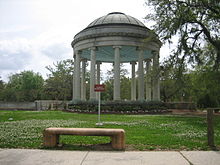- City Park (New Orleans)
-
This article is about the urban park. For the New Orleans neighborhood, see City Park, New Orleans.
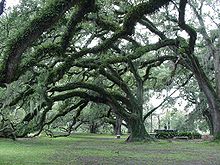 Centuries-old Live Oak trees, located near City Park Avenue in the oldest section of the park.
Centuries-old Live Oak trees, located near City Park Avenue in the oldest section of the park.
City Park, a 1,300 acre (5.3 km²) public park in New Orleans, Louisiana, is the 6th-largest and 7th-most-visited urban public park in the United States. City Park is approximately 50% larger than Central Park in New York City[1], the municipal park recognized by Americans nationwide as the archetypal urban greenspace. Although it is an urban park whose land is owned by the City of New Orleans, it is administered by the City Park Improvement Association, an arm of state government, not by the New Orleans Parks and Parkways Department. City Park is very unusual in that it is a largely self-supporting public park, with most of its annual budget derived from self-generated revenue through user fees and donations. In the wake of the enormous damage inflicted upon the park due to Hurricane Katrina, the Louisiana Department of Culture, Recreation and Tourism began to partially subsidize the park's operations.[2]
City Park holds the world's largest collection of mature live oak trees, some older than 600 years in age. Its founding in 1853 also makes it one of the oldest parks in the country.
Contents
History
City Park was established in the mid-19th century on land fronting Metairie Road (now City Park Avenue), along the remains of Bayou Metairie, a former distributary of the Mississippi River. The park originally extended only a short distance back from City Park Avenue, as swampland covered most of the landscape between Bayou Metairie and the south shore of Lake Pontchartrain. This area, to the north of the original park, was actually platted for streets by city planners, though none were ever realized.
In the first two decades of the 20th century, numerous improvements were undertaken by the City Park Improvement Association. Notable park landmarks like the Casino, the Peristyle, Popp Bandstand, Lelong Drive and the Issac Delgado Museum of Art were constructed. City Park's governing board also accomplished a number of large land acquisitions, such that the park assumed its current boundaries.[3] A master plan, by Bennett, Parsons & Frost of Chicago was commissioned to guide the development of the greatly enlarged park; this plan was largely implemented in the 1930s by numerous federal relief agencies, such as the Works Progress Administration.
Substantial improvements were made to the park's newly-acquired land by the Works Progress Administration, including the installation of many sculptures by WPA artist Enrique Alferez, construction of buildings, bridges, roads, and much of the electrical and plumbing infrastructure that were still serving the park when Hurricane Katrina struck in 2005. A formal rose garden was developed, the genesis of today's New Orleans Botanical Garden. The WPA also planted Couterie Forest and constructed Popp Fountain, City Park Stadium, a second 18-hole golf course - home for many years to the New Orleans Open golf tournament - and a golf clubhouse, which was later partially demolished to accommodate I-610.
After World War II, two additional 18-hole golf courses were added, I-610 was constructed through the park, a new golf clubhouse was erected, the Wisner Foundation subsidized the development of a scenic parkway running almost the entire length of Bayou St. John (Wisner Boulevard), and multiple rounds of expansion and improvement occurred involving various park facilities. By the 1970s, City Park featured four 18-hole golf courses, over 50 tennis courts, numerous other athletic fields and facilities, and the newly-expanded New Orleans Museum of Art. However, as was the case with many urban parks during this period, City Park began to suffer neglect, the result of insufficient maintenance due to budget cuts. Towards the end of this period the Friends of City Park were formed (1979) to rally support and raise resources for the park.
Since 1999, City Park has been the venue for the Voodoo Experience, which has become the largest of the live music events held in the park.
Hurricane Katrina did extensive damage to the park, with winds toppling an estimated 1,000 trees and damaging many more. The subsequent failure of multiple floodwalls brought about the inundation of much of the city, and almost the entire park was flooded with 1 foot (0.30 m) to 10 feet (3.0 m) of water that remained for two to four weeks, damaging all buildings, amusement rides, maintenance equipment, electrical systems and vehicles, and causing the death of more trees and landscaping - including nearly the entire plant collection in the New Orleans Botanical Garden.
As of 2011, City Park is administered and being redeveloped according to its 2005 master plan, the existence of which proved invaluable to the effective channeling of rebuilding assistance in the wake of Hurricane Katrina.
The park is recovering, repairing old attractions and adding new ones as well. Most facilities have reopened, including Storyland, the stadiums, the Botanical Garden, and Carousel Gardens. A dedicated bikeway was added between Wisner Boulevard and Bayou St. John for the length of the parkway, another was installed between Bayou St. John and Marconi Drive along the park's northern boundary, and a third was introduced alongside Harrison Avenue. Most recently, a landscaped walk debuted surrounding Big Lake, adjacent to the New Orleans Museum of Art. This new amenity, called for in the park's 2005 master plan, has realized the long-held wish of surrounding neighborhoods for a pedestrian- and bicycle-only scenic walk akin to the popular facility long offered in Audubon Park, Uptown.
Facilities
City Park has dozens of attractions that make it a popular destination in Greater New Orleans.
- Carousel Gardens Amusement Park - features a miniature train, a small roller coaster and several other rides, and one of the few remaining antique, carved wooden carousels in the country. The carousel turned 100 years old in 2006.
- Storyland – a children’s fairy tale themed playground that features twenty-six larger than life storybook exhibits for kids to climb on, slide down, or pretend within.
- New Orleans Botanical Garden – a lush 13-acre (53,000 m2) site containing a large collection of temperate, tropical, and semitropical plants. The Garden is also home to the New Orleans Historic Train Garden, a G-scale model railroad exhibit with houses representing the various neighborhoods of the city recreated in twigs, bark, and other plant matter.
- Celebration in the Oaks – a popular holiday light and entertainment extravaganza that generates 13 percent of the park’s annual operating budget. The event, originally called "Christmas In the Oaks," included a two-mile (3 km) driving tour of exhibits placed throughout the park and a separate walking tour of the Botanical Garden, Storyland, and the Amusement Park. The Friends of City Park began this popular annual fundraiser. As of the 2008 Christmas season, only the walking tour has returned.
- New Orleans Museum of Art – originally named the Delgado Museum of Art, the New Orleans Museum of Art is considered one of the finest art museums in the South.
- Sydney and Walda Besthoff Sculpture Garden – opened in 2003, the Besthoff Sculpture Garden features over 30 works of world-renowned sculptures in a beautifully landscaped area featuring mature live oak trees.
- Weddings & Catering – venues within the park host hundreds of weddings and other functions throughout the year. The park is the largest non-hotel caterer in the city.
- Historic Structures – the Peristyle, Popp Bandstand and the Casino Building were constructed between 1907 and 1917. Popp Fountain was added in 1937.
- City Park Golf Courses – on the eve of Hurricane Katrina the park boasted three 18-hole golf courses, one of which was once home to the city’s PGA tournament. The courses were damaged by Katrina-induced flooding. One course "The North Course at City Park" reopened in 2008 after undergoing a slight redesign with new greens and tees. The land that contained the former East and West courses is awaiting redevelopment. Several plans have been discussed.
- City Park Driving Range – a 100-tee, double decker driving range.
- Softball and Soccer – the park offers more than a dozen softball and soccer fields.
- Tad Gormley Stadium - originally known as City Park Stadium, this multipurpose arena seats 26,500 and was built by the Works Progress Administration. It was renovated for the 1992 US Olympic Track and Field Trials and in July 2005 was home to the Jr. Olympics track and field competitions. After Reggie Bush was drafted by the New Orleans Saints, he donated over $80,000 to repair Katrina-induced damage to the field, so that area high school football teams had a place to compete. In acknowledgement of Bush's generosity, Tad Gormley's playing field is recognized as Reggie Bush Field.
- Pan American Stadium - a 5,000 seat stadium, home of the New Orleans Jesters USL Premier Development League soccer team. The stadium also plays host to many high school football games as well as numerous additional soccer matches.
- Track – the 400-meter, international track was designed as a practice track for the 1992 US Olympic Track & Field Trials.
- Tennis – the City Park Tennis Center, featuring rubico and hard courts, is one of the largest municipal tennis facilities in the South.
- Boating and Fishing – the Park features 11 miles (18 km) of lagoons, lakes and bayous stocked with a wide variety of fish, including bass. Boating returned to City Park in 2009. Fishing is allowed seasonally. The park also hosts an annual fishing rodeo - one of the oldest in the nation.
- Horse Stables – Equest Farm offers boarding for horses, party accommodation, and equestrian lessons. The park has also historically housed the New Orleans Police Department's stables.
External links
- New Orleans City Park official website
- Celebration in the Oaks
- Friends of City Park
- Equest Farm
- New Orleans Museum of Art and Besthoff Sculpture Garden
- New Orleans City Park Amusement Park Photos
References
- ^ "America's Most Visited City Parks" (PDF). tpl.org. Archived from the original on 2006-07-25. http://web.archive.org/web/20060725034722/http://www.tpl.org/content_documents/ccpe_MostVisitedParks.pdf. Retrieved 2006-08-30.
- ^ "About City Park". neworleanscitypark.com. http://www.neworleanscitypark.com/about.html. Retrieved 2006-08-30.
- ^ "City Park History". neworleanscitypark.com. http://www.neworleanscitypark.com/history.html. Retrieved 2006-08-30.
Coordinates: 30°00′07″N 90°05′35″W / 30.002°N 90.093°W
City of New Orleans Topics History · Geography · Demographics · Economy · Culture · Healthcare · Media · Music · Sports · Architecture · Tourism · Education · Notable people · Skyscrapers · Streetcars · Flag · Lists

Government Neighborhoods Wards: 1st · 2nd · 3rd · 4th · 5th · 6th · 7th · 8th · 9th · 10th · 11th · 12th · 13th · 14th · 15th · 16th · 17th Categories:- Parks in New Orleans, Louisiana
- Urban public parks
- Works Progress Administration in Louisiana
Wikimedia Foundation. 2010.

